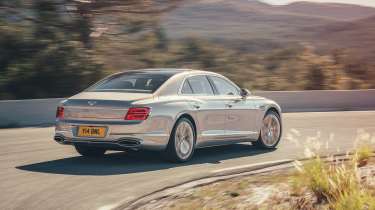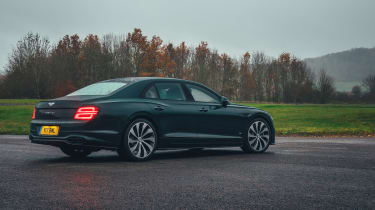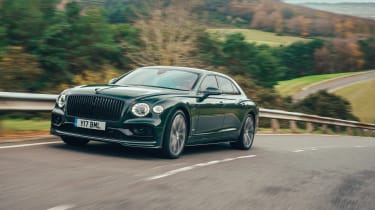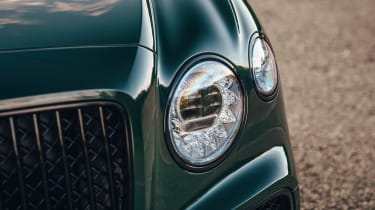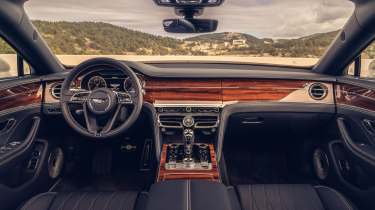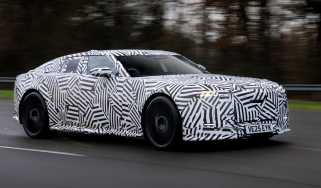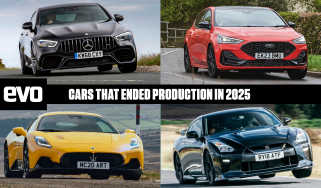Bentley Flying Spur (2019 - 2024) review
The Bentley Flying Spur is one of the few, if not the only, luxury car that is as good to drive as it is to be driven in
Bentley’s third-generation Flying Spur had two roles to play following the retirement of the Mulsanne. Not only did it need to provide the four-door alternative for Continental GT customers who need the additional space, but it is now also the company’s standard bearer: the flagship that represents Bentley and its best.
Thankfully it started from a very good place, the latest Continental GT being light years ahead of the car it replaced in 2018 in every conceivable area, a Bentley that delivers on the driving side as much as it does on the luxury, which hasn’t always been the case. It means the Flying Spur couldn’t have hoped for a stronger foundation to be built on.
> Bentley Flying Spur 2025 review – ultimate luxury, supercar pace
Engine, transmission and 0-60mph
The pre-facelift Flying Spur was available with three powertrains: V8, W12 and hybrid V6. The W12 remains one of the finest examples of refined power. It still has a bark when poked and encouraged, but for the majority of time the W12 performs as you would expect a 6-litre, 12-cylinder engine with a couple of lightly stressed turbochargers to.
As with the Continental GT there was a ZF-sourced eight-speed dual-clutch transmission, which connects to the W12 via a dual-mass flywheel and has allowed Bentley to equip the Flying Spur with a launch mode, which goes some way to explaining the 3.7 second 0-60mph time. Faster gearshifts thanks to the pre-selecting capability of the gearbox reduce lag between torque delivery to all four wheels via the car’s adaptive four-wheel-drive system, a system that also means the Spur is rear-wheel drive until it needs to be four-wheel drive, at which point torque is distributed to the front axle accordingly.
More reviews
Further functions of the four-wheel-drive system include a torque limiting function, with up to 354lb ft of the 664lb ft total sent to the front axle in Comfort and Bentley modes, whereas in Sport mode front axle torque is restricted to 206lb ft. Regardless of the driving mode the torque delivery is managed across each axle by Bentley’s torque-vectoring-by-braking system, first developed for the Continental GT3-R Supersports. Top speed – 207mph – is reached in sixth gear, with seventh and eight calibrated for cruising and maximum fuel efficiency.
The 4-litre V8 variant produces 542bhp, arrives at 6000rpm with 568lb ft of torque available across a 2500rpm window starting from 2000rpm. It’s sent to all four corners of the Flying Spur’s chassis via an adaptive four-wheel drive system and a ZF eight-speed dual-clutch gearbox. Against the clock it will reach 60mph in 4sec and top 198mph, which for a car weighing 2330kg is no mean feat. The V8 engine weighs 65kg less than the mighty W12.
Unlike the new 2025 car, the pre-facelift hybrid made do with a V6. A plug-in system with a 14.1kWh battery charged by a permanently magnetised motor positioned between the 2.9-litre twin-turbo V6 engine and transmission, to be specific. And when you’re not calling upon the regenerative capabilities of the V6 powertrain, all 410bhp and 406lb ft of it, you can plug the Flying Spur into a charger, where it will draw a maximum of 7kW to charge the 14.1kWh battery. A two and half hour 0-100% charge time isn’t very modern, but Bentley knows its customers have driveways and garages and a home charger hardwired to the mains that will allow them to always start their journey with a full battery. When you stretch the V6 and trouble its redline it’s a little coarse for what you would expect from a Bentley, although it’s unlikely to be a deal-breaker for many.
Technical highlights
With an active four-wheel-drive system, the Flying Spur benefits from a drivetrain that can manage torque depending on the selected driver mode. Comfort, Bentley (the set-up the engineers feel the car performs at its best in) and Sport (which sends the lowest percentage of the engine’s torque to the front axle compared to the other modes) all provide the ‘most dynamic driving experience with the crispest responses’ depending on your mood.
Taken from the 2014 Continental GT-3 R Supersports model, the torque-vectoring-by-braking system has been thoroughly overhauled to suit the Flying Spur’s characteristics and weight, splitting the torque further by adjusting the level delivered to each individual wheel as required.
For the Flying Spur the front axle has been positioned further forward to allow the W12 motor to fit, with the engine’s sump split by the axle. Active anti-roll bars and four-wheel steering, which are both part of the car’s 48-volt electrical system, plus three-chamber air suspension, revised tracks and an increased wheelbase length are all bespoke to the Flying Spur, too.
Away from the oily bits the technology continues inside, with ten driver assistance systems available, from night vision to 360 degree cameras, all of it powered by a lighter, more efficient electrical system that has allowed Bentley to reduce the number of 12-volt batteries required in the car from two to one.
Then there are the connected services: Apple CarPlay, Wi-Fi hotspots, head-up displays, traffic sign recognition software and active heating systems. Plus the digital screens, including a 12.3-inch touchscreen in the centre console.
What’s it like to drive?
If you’ve driven a second-generation Flying Spur forget everything about that model, because this car shares only its name. When it comes to driving, everything else about how it feels from behind the wheel is on a much higher level.
A car’s design shouldn’t have an effect on how it drives, but rear three-quarter aside, which looks a little too close to a Volvo S90 for some, the Flying Spur’s superformed aluminium body is so much more elegant and soothing on the eye that it makes its predecessor’s body look rather bland and heavy surfaced by comparison. The Spur has you in the right mood as soon as you approach it.
The interior, too, lifts your spirits. Yes, there are recognisable VW Group parts in here, predominantly the instruments and infotainment system, but the fit and finish of every detail, the magic of the three-dimensional leather, the sense of being wrapped in luxury, combines to create a rarefied atmosphere of subtle indulgence. As a replacement for the Mulsanne, the Flying Spur has it covered.
And then you start the W12. It rumbles gently before settling almost silently and, unless you want to, you won’t hear much from it again. Of course it glides around in absolute serenity, but you’d expect it to do that because it’s a 5.3-metre-long limo designed to be the most refined car you can buy. The eight-speed transmission irons flat the drivetrain, you seem to just reach the required speed with barely a joint of your body moving, nor you noticing a mechanical part in operation. But it doesn’t last long if you appreciate quality engineering and exploring a car’s outer reaches.
Because before long you realise the Flying Spur has an agility that’s as impressive as its imperious quality. The active roll-bar system, developed with Audi, is far superior to any application on any VW Group product. The Bentley doesn’t corner flat like a GT3 RS, but you wouldn’t want it to. What it does do is move with a precision rivalling the fit and finish of the body panels. It surprises you with its delicacy, and before long you’re travelling at a pace and with a level of enthusiasm you might normally expect to experience behind the wheel of an M5, not a 2437kg Bentley. Not that this is an M5 rival you understand, rather it encourages you to enjoy yourself like the best supersaloons do, while remaining totally within itself.
Its four-wheel steering plays an insignificant part In this, adding to the agility required to make you feel comfortable exploring the W12’s 626bhp, which in turn benefits from the active four-wheel drive. Leaving the car in Bentley mode leaves you impressed, winding it up to Sport feels a little like overkill for a car that carries two crystal glasses in its rear-seat fridge, but if you feel inclined to spill your passengers’ drinks, the Flying Spur will happily be your accomplice.
What really makes this Flying Spur stand out is its ability to be what you need it to be. If time allowed you would never bother with a short-haul flight again, the Spur being the only genuine rival to an S-class as the car you’d happily drive for 12 hours straight. That it will be more fun should some of the roads be interesting is the icing on the cake.
It’s not an evo car in the truest sense, but it is a car that appeals to evo’s appreciation for automobiles that are designed for a purpose and nail the brief with unnerving accuracy. It’s one of the ultimate guilty driving pleasures you can buy.
Move away from the W12 and things improve further still. We knew the fitment of the lighter V8 engine would improve an already good package, because it did just that when the same strategy was applied to the Continental GT. What we perhaps weren’t expecting was such a big step up. There's a 107kg weight difference between the W12 and V8 Flying Spurs, and while that might equal less than five percent of total weight it adds considerably more to how the smaller engined car drives.
It feels lighter on its Pirellis, with the sensation that the W12 is pushing the tarmac into submission replaced with a sense that the V8 is able to work better with the surface and around the challenges. It’s at its most noticeable when you begin to drive a little harder, with the combination of the V8’s sharper reactions and more eager nature matched to the Flying Spur’s more natural approach to a dynamic challenge. It’s a calmer car to drive quickly, requiring fewer inputs to keep the nose where you want it go and when you ask it to react with very short notice it doesn’t leave you high and dry, worrying how you’re going to explain the sizable hole you’ve just created.
Much of the V8 Flying Spur’s ability can be traced to its three-chamber air-suspension and active dampers. With both W12 engined cars - Conti and Spur - it feels at its limit, working against the weight distribution and the nature of the car’s performance delivery, but with the lighter engine and improved weight distribution it feels perfectly suited to the Spur V8 and is certainly the best integration of the system we’ve experienced.
It manages body roll in such a controlled manner you barely notice it until you need to. Likewise pitch and yaw don’t leap out at you or shock, rather the system manages the movement to give the right level of feedback to let you know what’s going on and what is required to manage it. It makes for a deceptively quick and unexpected cross country machine.
Add to this the ability to master monster mileage with an effortlessness and grace few can match and an interior that you never want to get out of and it’s not long before you’re fighting your beliefs on how cars should be all circa 1000kg, short of wheelbase and with a naturally aspirated engine and manual gearbox.
Opt for the V6 hybrid and you carry an additional 175kg, but do you notice the additional weight? 99 per cent of Flying Spur drivers won’t, even if they have come from a V8-powered example, and not only because the Hybrid is just a tenth slower when it comes to the sprint benchmarks and still tops 177mph. Because away from the road testing and performance figures and the stopwatches the Flying Spur Hybrid is every bit as quick as a V8 when you want and need it to be. With the V6 running and the electric motor charged and primed there’s a combined 553lb ft of torque to hustle you along, and it does so with little effort required as the instantaneous delivery of electric torque blends seamlessly with the turbocharged V6’s 98 RON generated twist and shove.


